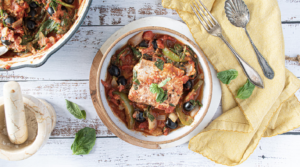Diarrhea. Constipation. Gas. Bloating. Belly pain.
Do you experience any of these symptoms? Have you turned down a social event or called off work because of them? Do you get bathroom anxiety or feel the need to know where the bathrooms are located wherever you go? Do you avoid eating out because it feels safer being close to your own bathroom?
If you answered yes to any of these questions you might be suffering from Irritable Bowel Syndrome (IBS), and your symptoms may be the result of consuming certain carbohydrates known as FODMAPs.
Research shows that a low-FODMAP diet is the most effective treatment for Irritable Bowel Syndrome (IBS) and IBS-like symptoms.
LOW FODMAP DIET
So what is a low FODMAP diet?
The “F” in FODMAP stands for fermentable. (bacteria can break these down in your intestines)
The “O” in FODMAP stands for the poorly absorbed fibers called oligosaccharides. (such as onions, garlic, wheat, and beans)
The “D” in FODMAP stands for disaccharides. (such as the lactose in milk and dairy products)
The “M” in FODMAP stands for monosaccharides. (such as fructose in many fruits, honey, high fructose corn syrup, and agave)
The “A” stands for and. (the easiest one to remember)
The “P” in FODMAP, stands for polyols. (such as sugar alcohols and artificial sweeteners)
How do FODMAPs trigger symptoms?
For healthy individuals, it takes about 12-48 hours for food to move from the mouth to the anus. The small intestine is about –20 feet long while the large intestine is about 5 feet long. It may sound backwards, but it has to do with the thickness and diameter of the organ. So given the time, it takes for food to move through the gut, symptoms experienced immediately after swallowing a suspect food cannot be attributed to the fermentation of FODMAPs. Most of the time it’s the impact of hormones and nerve regulators that are activated when we eat.
Think about it this way, when we eat food, it enters the stomach, and hormones are released as a result. These hormones stimulate the production of enzymes that aid in digestion. When the ingested food stretches the stomach, the nerves in the digestive system are activated and the muscles of the intestine push food and digestive juices through the gut.
Because digestion takes many hours, or even days, the intestinal tract is always full of digestive contents from a prior meal. As a meal is consumed, the existing intestinal contents are moved through the intestines.
So if the existing intestinal contents contain FODMAPs, or other problematic foods, you could experience symptoms upon eating that has nothing to do with the current meal and everything to do with the previous meal/s. I know this can be confusing and often can make it difficult to pinpoint the actual trigger food.
On another note here, this is why we run food sensitivity panels with our 1:1 clients to get more specific and detailed data on the specific foods causing issues.
This is also why it’s important to log and track what you’re eating so that we have a record of past meals. Because let’s be realistic, who can remember EXACTLY what they ate two days ago for lunch?! Another important factor we always consider when addressing symptoms is stress. Stress can impact bowel function and the severity of the symptoms people experience! Lack of sleep as well!
HOW TO APPLY THE DIET
With our 1:1 clients, we break down the low FODMAP diet into 3 phases.
Phase 1: Elimination for 2-6 weeks.
Goal: Remove all high FODMAP foods to provide symptom relief.
Phase 2: Determine Sensitivities for 6-8 weeks
Goal: Systematically add FODMAP subtypes back into the diet to identify triggers.
Phase 3: Personalization for as long as needed to manage symptoms
Goal: Add back in successfully eliminated FODMAP foods to expand diet to personal tolerance and to avoid nutritional deficiencies.
FOODS TO ELIMINATE
What foods are considered high FODMAP?
- Some vegetables such as onions, garlic, savoy cabbage, cauliflower, snow peas, asparagus, artichokes, leeks, beetroot, sweet corn, brussels sprouts, red bell peppers, corn, fennel bulb, peas, butternut squash, red cherry tomatoes, and mushrooms
- Some fruits, such as peaches, apricots, nectarines, plums, prunes, mangos, apples, pears, watermelon, cherries, cranberries, brown bananas, blueberries, and blackberries
- Dried fruits such as dates, figs, goji berries raisins, prunes, and fruit juice concentrate
- Beans and lentils
- Wheat, Rye, and Barley (bread, cereals, pasta, crackers, pizza, et.)
- Dairy products that contain lactose (milk, soft cheese, yogurt, ice cream, custard, pudding, cottage cheese, etc.)
- Some nuts, including cashews and pistachios
- Sweeteners and artificial sweeteners (high fructose corn syrup, honey, agave nectar, sorbitol, xylitol, maltitol, mannitol, isomalt (commonly found in sugar-free gum and mints, and even cough syrups)
- Drinks (alcohol, sports drinks, coconut water, etc.)
FOODS TO INCLUDE– GO FOODS!
What foods are safe to eat?
- Vegetables such as alfalfa sprouts, arugula, bean sprouts, bamboo shoots, bok choy, broccoli heads (florets only); red, green, and Chinese cabbage; green bell pepper, carrot, celeriac, green beans, spinach, spaghetti squash, cucumber, collard greens, baby corn, hearts of palm, kale, jicama, kohlrabi, lettuce, okra, pumpkin, Roma tomatoes, bamboo shoots, eggplant, ginger, chives, olives, parsnips, potatoes, rutabaga, and turnips
- Fresh fruits like oranges, star fruit, clementine, fresh cranberries, cumquat, dragon fruit, guava, papaya, firm banana, pineapple, plantain, grapefruit, kiwi, lemon, lime, and strawberries (5 or less).
- Dairy that is lactose-free, and hard cheeses, or ripened/matured cheeses including brie, camembert, and feta cheese, to name a few (If you are not lactose intolerant, you may not need to avoid dairy with lactose).
- Protein sources such as grass-fed beef, pasture-raised pork, organic chicken, low mercury fish, and pasture-raised eggs (avoid breadcrumbs, marinades, and sauces/gravies that may be high in FODMAPs).
- Soy products including firm tofu, tempeh, gluten-free soy sauce, edamame
- Grains like rice, rice bran, oats, oat bran, quinoa, cornflour (corn starch), sourdough spelled bread, gluten-free bread, and pasta. (Gluten itself is not a FODMAP, but many gluten-free products tend to be low in FODMAPs).
- Plant-based milk like almond milk, rice milk, and coconut milk (no inulin)
- Beverages such as tea and coffee (use plant-based milk or creamers), natural squeezed fruit juice (not from concentrate or juice of any of the fruits to eliminate list), and water (add lemon or lime for a fresh twist!)
- Nuts and seeds like pumpkin seeds, almonds, macadamia nuts, peanuts, pine nuts, walnuts (fewer than 10-15 per serving for nuts)
PORTION MATTERS
For certain foods, the portion size makes a difference as to whether it has a high level of FODMAPs to cause symptoms.
The low FODMAP diet is part of the medical nutrition therapy we employ for those with IBS and SIBO. Research has found that it reduces symptoms in about 86% of people. Those are great odds and our clients reap the benefits!
Because the diet can be challenging during the beginning, it’s important to work with a registered dietitian. If you are suffering from these symptoms, reach out to us at the
MFN team to ensure you’re following the diet correctly, addressing the root cause, and maintaining proper nutrition in the process.
Click HERE for a low FODMAP recipe that can be made ahead, and is perfect for a quick easy lunch this spring! Let us know if you try it!
Your Online Dietitian Coach, Ashley Anderson MS, RDN, LDN, CPT, PN1

Your Online Dietitian Coach, Rachel Brown, RD, IBCLC, CDECS, MBA

***Click I’M READY to fill out our coaching application to schedule a complimentary discovery call TODAY! A healthier you is just a call away!***
Resources:
- MONASH APP*
- Monash University. Monash University. Published 2000. https://www.monash.edu/
- The Low FODMAP Diet Approach: Effects of FODMAPs on the Gut – About IBS. About IBS. https://aboutibs.org/treatment/ibs-diet/low-fodmap-diet/effects-of-fodmaps-on-the-gut/
- Maggie S, Lembo A. Low-FODMAP Diet for Treatment of Irritable Bowel Syndrome. Gastroenterology & hepatology. 2012;8(11):739-745. https://www.ncbi.nlm.nih.gov/pmc/articles/PMC3966170/



